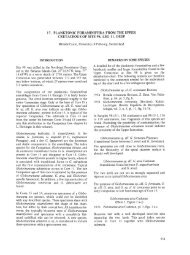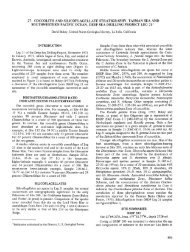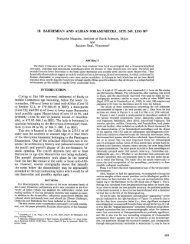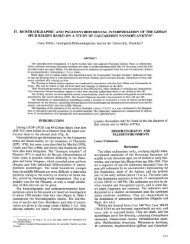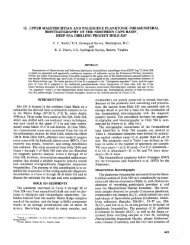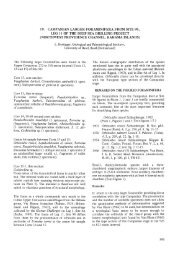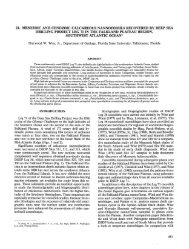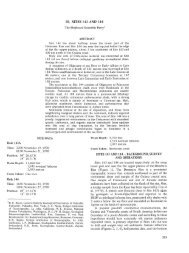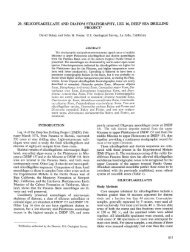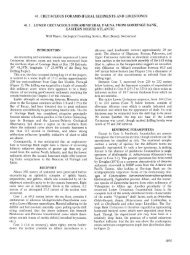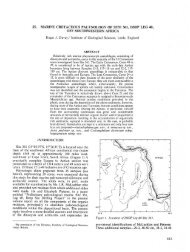16. Radiolaria - Deep Sea Drilling Project
16. Radiolaria - Deep Sea Drilling Project
16. Radiolaria - Deep Sea Drilling Project
You also want an ePaper? Increase the reach of your titles
YUMPU automatically turns print PDFs into web optimized ePapers that Google loves.
M. G. PETRUSHEVSKAYA, G. E. KOZLOVA<br />
Stylodictya inaequalispina Clark and Campbell<br />
(Plate 18, Figure 8)<br />
Stylodictya inaequalispina Clark and Campbell, 1942, p. 45, pi. 3,<br />
fig. 5.<br />
Disc diameter 150-190µ; width of rings 12µ, pore diameter 4-6µ<br />
(in center 2µ), length of spines up to 50µ.<br />
Eocene-Oligocene.<br />
Stylodictya rosella, Kozlova sp. n.<br />
(Plate 18, Figure 9)<br />
Stylodictya sp. Clark and Campbell, 1945, p. 24, pi. 3, fig. 19.<br />
Central chamber is surrounded by 9-11 slightly curved (scalloped)<br />
annular systems, each system doubling in size beginning in<br />
the center to the edge of the disc; pores are found, 2 or 3 on each<br />
ring, approximately of the same size; there are up to twenty-four<br />
inner spines of uniform thickness; at the rim of the disc they appear<br />
either as thin spicules or as massive flat teeth.<br />
Disc is very thin in its central part and becomes very thick at the<br />
rim (the last 5 to 6 rings).<br />
Disc diameter 250-270µ, width of rings 7-16µ, pore diameter<br />
3-4µ; diameter of the first system 24µ.<br />
It differs from S. targaeformis (see below) by larger dimensions,<br />
the thickness along its rim, and by a greater number of spines.<br />
Eocene-Oligocene.<br />
Stylodictya targaeformis (Clark and Campbell)<br />
(Plate 18, Figure 10)<br />
Staurodictya targaeformis Clark and Campbell, 1942, p. 43, pi. 3,<br />
fig. 6.<br />
Specimens from Atlantic have eight external spines.<br />
Disc diameter 170-200µ; width of rings 5-10µ; pore diameter<br />
2-5µ, length of spines 40µ; diameter of the first system 30µ.<br />
Eocene-Oligocene.<br />
Stylodictya orbiculata (Haeckel)<br />
(Plate 18, Figure 7)<br />
Trematodiscus orbiculatus Haeckel, 1862, pi. 28, fig. 2.<br />
Porodiscus orbiculatus Haeckel, 1887, p. 492.<br />
Disc diameter 125-140µ, width of rings 7-15µ;pore diameter 5µ.<br />
Eocene-Oligocene.<br />
Stylodictya aculeata (Jörgensen)<br />
(Plate 18, Figure 6)<br />
Stylodictya aculeata Jörgensen, 1905, p. 119, pi. 10, fig. 41;<br />
Petrushevskaya, 1967, p. 35, pi. 11, figs. 1-3.<br />
Quaternary.<br />
CIRCODISCUS Kozlova, new genus<br />
Porodiscus Haeckel, 1881, p. 491, (part.); Ommatodiscus Stöhr,<br />
1880, p. 115 (part.); Flustrella Campbell, 1954, p. 89 (part.)<br />
Type species Trematodiscus microporus Stöhr, 1880, p. 108, pi.<br />
4, fig. 17.<br />
Slightly convex skeleton with round or oval outline. Consists of<br />
frontal, sagittal and equatorial girdles, their wings connected to<br />
form regular round or oval rings.<br />
First system is of the Trizonium type {in sensu Haeckel), its<br />
dimension 30-40µ, with fully developed girdles; in the rest of<br />
them, only the equatorial girdle is fully developed; saggital and<br />
frontal girdles terminate at the point of the junction with the ring of<br />
the previous system; distance between (width of rings) is considerably<br />
larger than the diameter of the central chamber. Spines (four<br />
main and four secondary) pass inside of the skeleton. Rim is<br />
smooth.<br />
It differs from Plectodiscus gen. nov., by the character of the<br />
connection of its wings and accordingly by the structure of the first<br />
system.<br />
The name is derived from Greek "Circos" (circle) and "Discos"<br />
(disk), masculine.<br />
Eocene-Recent.<br />
Circodiscus microporus (Stöhr)<br />
(Plate 19, Figure 1-7)<br />
Trematodiscus microporus Stöhr, 1880, p. 108, pi. 4, fig. 17.<br />
Porodiscus microporus Stöhr, Haeckel, 1887, p. 493.<br />
526<br />
Skeleton is oval, flat, consisting of 3 or 4 comparatively wide,<br />
oval, annular girdles; pores are even, circular, 5 or 6 on each ring.<br />
Inner spines (8?) do not extend outside; rim of the disc seldom has a<br />
smooth, clearly outlined tapered edge; more often it is "torn" and<br />
disconnected.<br />
Disc diameter with four systems 180-200µ width of rings<br />
25-35µ, pore diameter 5-8µ.<br />
Miocene-Quaternary.<br />
Circodiscus sp.<br />
(Plate 19, Figure 8)<br />
From C. microporus it differs by having wider rings and smaller<br />
pores.<br />
Disc diameter (with three systems) 160µ, width of rings 3040µ,<br />
pore diameter 3-4µ.<br />
Miocene.<br />
Genus PLECTODISCUS Kozlova, new genus<br />
Discospira Haeckel, 1862 (part.); Porodiscus Haeckel, 1882, p. 492<br />
(part.); Flustrella Campbell 1954, p. 89 (part.). Type species<br />
Porodiscus circularis Clark and Campbell, 1945, p. 42, pi. 11,<br />
figs. 2, 6, 10.<br />
Thin, biconvex skeleton, with oval, less frequently circular<br />
outline, consisting of frontal, equatorial and sagittal girdles. The<br />
closed-spiral structure of girdles is of the Spironium type: wings of<br />
the same type of girdle form a one-half turn of the spiral, and at the<br />
point of their juncture overlap each other. First system has fully<br />
developed girdles, its dimensions are 40 × 50µ; in the rest of the<br />
girdles, only the equatorial girdle is fully developed, both saggital<br />
and frontal girdles terminating at the point of their junction with<br />
the previous system. Distance between rings is greater than is the<br />
diameter of the central chamber. Inner spines are indistinct; rim of<br />
the disc is smooth or is covered by numerous short spines.<br />
Depending on the degree of inclination of the plane of the<br />
girdles in relation to the main axes of the skeleton, the equatorial<br />
girdles appear from the surface (rest of girdles in corresponding<br />
cross-section) in the form of rings, as a single or double spiral, or in<br />
the form of rings connected by zigzag radial lines.<br />
The name is derived from Greek "plecta" (interlacing) and<br />
"Discos" (disk), masculine.<br />
Paleocene-Oligocene.<br />
Plectodiscus circularis (Clark and Campbell)<br />
(Plate 19, Figures 9-12)<br />
Porodiscus circularis Clark and Campbell, 1942, p. 42, pi. 11, figs. 2,<br />
6, 10.<br />
Porodiscus uralicus Lipman, 1960, p. 86, pi. XI, figs. 9-11;<br />
Porodiscus durus Moksyakova, p. 146, pi. 2, fig. 8.<br />
Skeleton is oval, less frequently circular in outline, consisting of<br />
4 to 6 systems, the width of which increases slightly from the center<br />
toward the rim of the disc; all possible varieties of the outer forms<br />
of the girdle are represented here: the enclosed-spiral (Plate-Figure<br />
12), annular (Plate-Figures 9, 10) and spiral; pores are round and of<br />
uniform size, four or five on the width of each system; disc rim is<br />
tapered; main and secondary radial spines are of uniform thickness<br />
and appear at the rim of the disc in the form of (16?) tiny spicules.<br />
Disc diameter 120-25Oµ, distance between systems 20-35µ, pore<br />
diameter 6-9µ.<br />
Paleocene?-Eocene. Paleocene forms have a coarser and larger<br />
skeleton.<br />
Plectodiscus bergontianus (Carnevale)<br />
(Plate 19, Figure 13)<br />
Porodiscus bergontianus Carnevale, 1908, p. 23, pi. 4, fig. 2.<br />
Porodiscus squinaboli Carnevale, 1908, p. 23, pi. 4, fig. 3.<br />
Disc diameter 230-240µ, width of rings 15-20µ, pore diameter<br />
5-7µ.<br />
This form differs from P. circularis by the greater number of<br />
systems and their smaller width.<br />
Eocene.<br />
Genus OMMATOCAMPE Ehrenberg<br />
Ommatocampe Ehrenberg, 1860, p. 852; Haeckel, 1887, p. 392;<br />
Campbell, 1954 p. 76. Type species Ommatocampe polyarthra<br />
Ehrenberg, 1872b, pi. 6, fig. 9.



